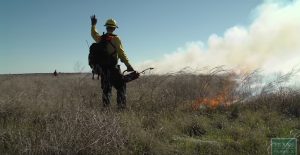Value of Fire on Turkey Habitat
This is Passport to Texas
We welcome rain in Texas as it promotes lush vegetative growth. Yet, in the absence of fire, such growth can become a problem.
The lack of fire on the landscape has been a big issue. Especially in East Texas, but across the state. We’re seeing a lot of our habitat go from those grasslands to being more dominated by woody vegetation.
Jason Hardin, Turkey Program Leader at Texas Parks and Wildlife, says woody vegetation with an open understory is good turkey habitat.
A turkey’s main defense is its eyesight. Its sense of smell isn’t much better than ours; it’s sense of hearing is good—but it’s not going to keep them alive. So, their vision is most critical for them. So, they need to be able to see where they’re going. If they can’t see through it and move through it easily, it’s not good habitat.
Fire creates an open understory, which affords usable space for turkey, especially in rainy East Texas.
When you see forty, fifty, sixty inches of rainfall a year—you’re going to get a lot of rapid growth on that woody cover. So, burning those forests is essential. We don’t have a fire culture in Texas; people know it’s important, but they’re scared of it. So, we’re trying to provide funding where we can, and work with partners to try and get fire on the ground with certified prescribed burn bosses doing that fire—some of our staff as well—to educate those landowners. And try to—as much as we can—begin to develop a culture that if they’re not willing to burn it themselves, at least they can support fire as a management tool.
The Wildlife Restoration Program Supports our Series.
For Texas Parks and Wildlife…I’m Cecilia Nasti.



 Passport to Texas is a
Passport to Texas is a  Passport to Texas is made available by:
Passport to Texas is made available by: